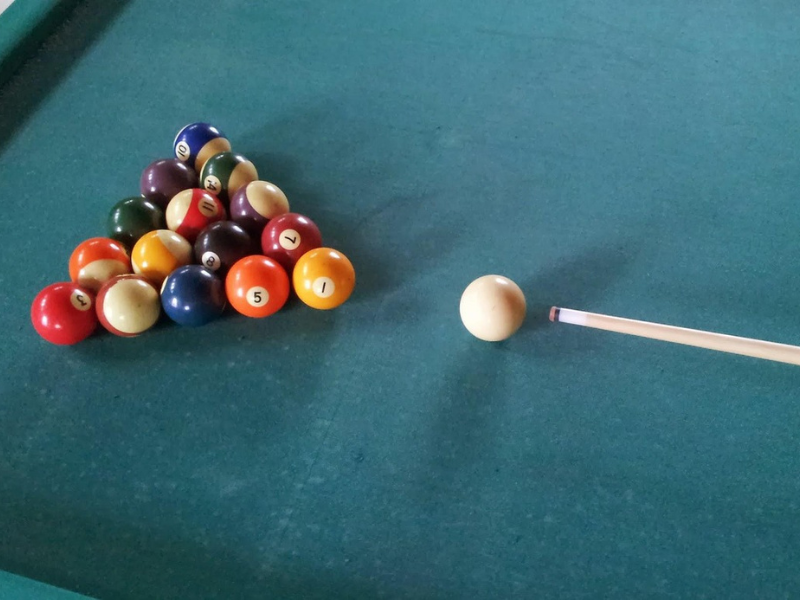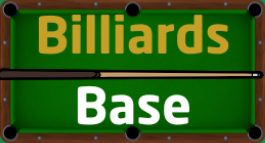American pool is one of the world’s most popular cue sports, played in bars, pool halls, and homes across the globe.
Whether you’ve just picked up a cue stick for the first time or you’re looking to understand the official rules after playing casually, this comprehensive guide will teach you everything you need to know about American pool rules.
What is American Pool?

American pool refers to cue sports played on larger tables with bigger balls compared to English pool. The most distinctive features include:
- Table size: Typically 7ft, 8ft, or 9ft long (compared to 6ft or 7ft for English pool)
- Ball size: 2.25 inches in diameter (larger than English pool’s 2 inches)
- Ball set: 15 numbered object balls plus one white cue ball
- Pocket size: Larger openings to accommodate the bigger balls
The two most popular American pool formats are:
- 8-ball: Players aim to pocket either “solids” (balls 1-7) or “stripes” (balls 9-15), then the 8-ball
- 9-ball: Players must hit balls in numerical sequence, aiming to pocket the 9-ball
Equipment and Table Setup
Standard Table Dimensions
American pool tables come in three main sizes:
- 7ft tables: 78″ x 39″ (bar/pub tables)
- 8ft tables: 88″ x 44″ (home tables)
- 9ft tables: 100″ x 50″ (tournament standard)
Ball Set Composition
A complete American pool set includes:
- Cue ball: White ball used to strike object balls
- Object balls 1-7: Solid colored balls (yellow, blue, red, purple, orange, green, maroon)
- Object balls 9-15: Striped balls with the same base colors
- 8-ball: Black ball (the “money ball” in 8-ball pool)
Racking for 8-Ball
The standard triangle rack setup for 8-ball:
- Place the 8-ball in the center of the triangle
- Put one solid and one stripe in the back corners
- Arrange remaining balls randomly, ensuring good distribution of solids and stripes
- Ensure the front ball is positioned on the foot spot
How to Play 8-Ball Pool: Basic Rules

Game Objective
The goal in 8-ball is straightforward:
- Choose your group (solids or stripes) by legally pocketing a ball
- Pocket all balls in your group
- Legally pocket the 8-ball to win
The Break Shot
- The player breaking must strike the racked balls with the cue ball from behind the head string
- Legal break requirements:
- At least four object balls must contact the cushions, OR
- At least one object ball must be pocketed
Determining Groups
After the break:
- The table is “open”, neither player has chosen a group yet
- The first player to legally pocket a ball claims that group (solids or stripes)
- The opponent automatically gets the remaining group
Turn Sequence
Players alternate turns, with each player shooting until they:
- Miss their intended shot
- Commit a foul
- Fail to pocket one of their group balls
Legal Shot Requirements
For a shot to be legal, you must:
- Strike one of your group balls first with the cue ball
- Cause any ball to contact a cushion after contact, OR pocket a ball
- Not commit any fouls (see next section)
Fouls and Penalties in American Pool
Understanding fouls is crucial for playing by the rules. Here are the most common fouls in American pool:
Common Fouls
- Cue ball scratch: Cue ball goes into a pocket
- Missed contact: Failing to hit any ball with the cue ball
- Wrong ball first: Hitting opponent’s group or the 8-ball before your group
- No cushion contact: No ball touches a cushion after legal contact
- Double hit: Cue tip contacts the cue ball twice in one shot
- Balls off table: Any ball leaves the playing surface
Penalty for Most Fouls
When a foul occurs:
- The fouling player’s turn ends immediately
- The opponent receives “ball-in-hand” – they can place the cue ball anywhere on the table
- Any balls pocketed during the foul shot are re-spotted (except the 8-ball)
Loss-of-Game Fouls
These fouls result in automatic loss:
- Pocketing the 8-ball before clearing your group
- Pocketing the 8-ball and cue ball on the same shot
- Pocketing the 8-ball in the wrong pocket (if called shots are required)
- Knocking the 8-ball off the table
How a Game Ends (Winning and Losing)
How to Win
You win an 8-ball game by:
- Legally pocketing all balls in your group (solids OR stripes)
- Then legally pocketing the 8-ball in your called pocket
How to Lose
You automatically lose if you:
- Pocket the 8-ball before clearing your group
- Pocket the 8-ball and scratch the cue ball
- Knock the 8-ball off the table
- Pocket the 8-ball in the wrong pocket (when calling shots)
Tie Situations
True ties are extremely rare in pool, as games typically end with a win/loss scenario. If a game reaches a stalemate (very uncommon), players may agree to re-rack and start over.
Suggested visual enhancement: Quick reference checklist showing win conditions and loss conditions for easy reference.
Other Popular American Pool Games (Brief Introduction)
While 8-ball is the most common format, other American pool games include:
9-Ball Pool
- Uses only balls 1-9 plus the cue ball
- Balls must be hit in numerical order (1, then 2, then 3, etc.)
- The player who pockets the 9-ball wins, regardless of who pocketed the other balls
- Uses a diamond-shaped rack instead of a triangle
10-Ball Pool
- Similar to 9-ball but uses balls 1-10
- More strategic as the 10-ball must be called
Straight Pool
- Players can shoot any ball at any time
- Games are typically played to a set number of points (usually 150)
- Requires calling both the ball and pocket for every shot
For detailed comparisons, see our guide on 8-Ball vs. 9-Ball: Rules and Key Differences
Etiquette and Good Habits for Beginners
Good pool etiquette makes the game more enjoyable for everyone:
Basic Table Manners
- Wait your turn: Never shoot out of turn or interfere with your opponent’s shot
- Keep quiet during shots: Avoid talking or moving while your opponent is shooting
- Handle equipment carefully: Don’t lean on the table or use your cue as a walking stick
- Call your shots when required: In formal games, announce which ball and pocket you’re targeting
Cue Care
- Chalk regularly: Apply chalk to your cue tip before difficult shots
- Store properly: Keep your cue in a case when not in use
- Handle with care: Avoid dropping or throwing cues
Respect for Opponents
- Acknowledge good shots: Compliment impressive shots by opponents
- Call your own fouls: Honest play builds respect and improves the game
- Shake hands: Start and end games with good sportsmanship
Frequently Asked Questions (FAQs)
What’s the difference between 8-ball and 9-ball?
8-ball uses all 15 object balls, and players must clear their group (solids or stripes) before attempting the 8-ball. 9-ball uses only balls 1-9, which must be hit in numerical order, and whoever pockets the 9-ball wins.
What is a legal pool break?
A legal break requires either: (1) at least four object balls to contact the cushions, or (2) at least one ball to be pocketed. If neither condition is met, it’s an illegal break and the opponent can re-rack or continue play.
Are jump shots and masse shots allowed in beginner games?
While these advanced techniques are legal under official rules, many casual games and bar rules prohibit them to prevent table damage. Always check local rules before attempting these shots.
What happens if the cue ball goes in a pocket?
This is called a “scratch” and is a foul. Your opponent gets ball-in-hand (can place the cue ball anywhere on the table) and any balls you pocketed on that shot are typically re-spotted.
Can I use English pool balls/rules on an American table?
While physically possible, it’s not recommended. The larger pockets and table size of American tables are designed for the larger American balls. English pool rules also differ significantly from American pool rules.
Conclusion and Next Steps
Learning American pool rules is just the beginning of your journey into this entertaining sport. The key to improvement is practice, start with basic 8-ball games to master the fundamental rules and shot-making techniques.
Consider these next steps to enhance your pool game:
- Join a local league: Many bars and pool halls offer beginner-friendly leagues
- Practice basic shots: Focus on straight shots and simple position play
- Watch experienced players: Observe technique and strategy at your local pool hall
- Invest in proper equipment: A personal cue stick can significantly improve your consistency
Remember, pool is meant to be enjoyable. Focus on learning the rules, developing good habits, and most importantly, having fun at the table!
